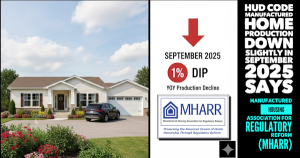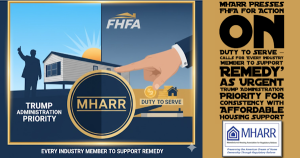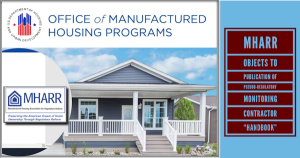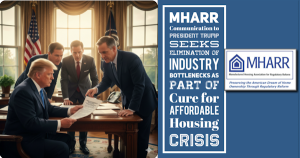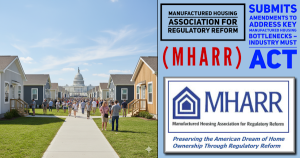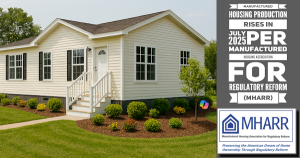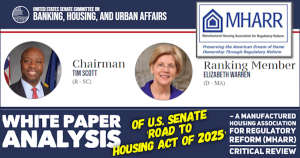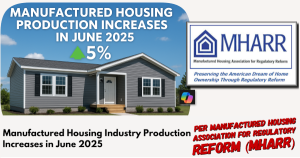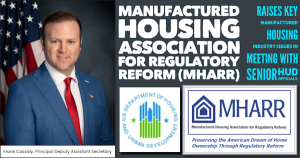Washington, D.C. Manufactured Housing Association for Regulatory Reform press release.
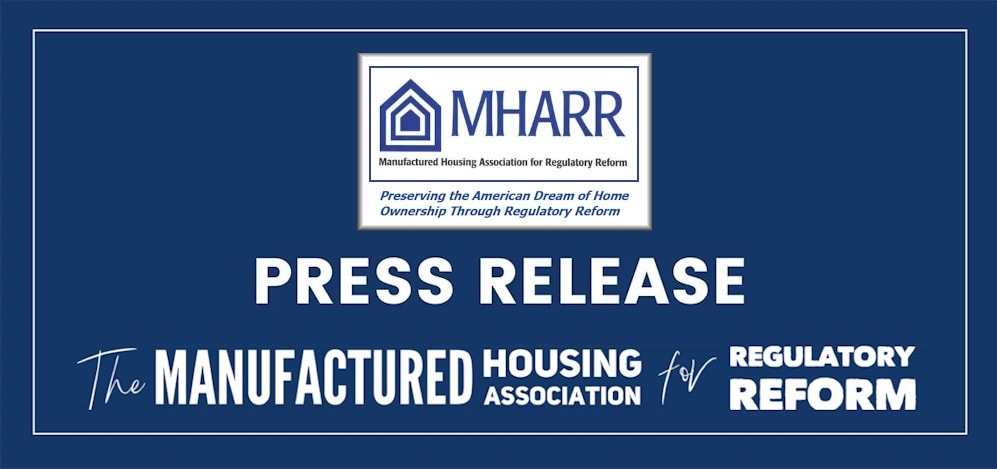
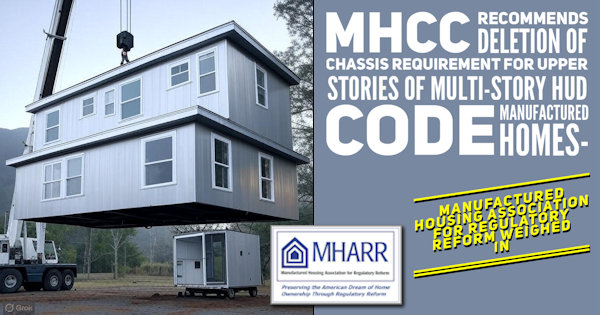
JUNE 25, 2025
TO: MHARR MANUFACTURERS
MHARR STATE AFFILIATES
MHARR TECHNICAL REVIEW GROUP (TRG)
FROM: MHARR
RE: MHCC RECOMMENDS DELETION OF CHASSIS REQUIREMENT
FOR UPPER STORIES OF MULTI-STORY MANUFACTURED HOMES
The statutory Manufactured Housing Consensus Committee (MHCC), at a conference call meeting on June 24, 2025, recommended the adoption, with slight modifications and additions, of a HUD-proposed amendment that would eliminate the regulatory “permanent chassis” requirement for the upper stories of multi-story HUD-Code manufactured homes. The requirement for a “permanent chassis” affixed to the ground floor, or lowest level of a multi-story manufactured home – being, at present, a statutory requirement contained in the language of the National Manufactured Housing Construction and Safety Standards Act of 1974, as amended — would remain under the HUD proposal considered by the MHCC,
As is normal practice in regulatory activity since the enactment of the Manufactured Housing Improvement Act of 2000 (2000 Reform Law), the MHCC-recommended proposal will now go back to HUD for further administrative action, including possible publication of a Notice of Proposed Rulemaking (NPR) in the future.
As MHARR made clear during introductory remarks, the Association, since its inception in 1985, has historically supported regulatory modifications that provide homebuyers with greater freedom of choice, more living options, and greater flexibility, while simultaneously reducing burdens on regulated industry members including, especially, smaller businesses that are disproportionately impacted by excessive regulatory burdens.
MHARR cautioned, however, against the adoption of any standards or requirement based upon or driven by the proprietary designs or unique proprietary interests of any one manufacturer or group of manufacturers, an action that would be inherently prejudicial to other – and particularly smaller, independent – manufacturers. As MHARR previously asserted with respect to so-called “Cross-Mod” homes, federal manufactured home construction and safety standards should not incorporate or be tailored to align with designs that are proprietary and not generically available to or accessible to all HUD Code manufacturers.
MHARR further asked if a study of the cost-benefit impacts of the proposed rule – specifically including free market competition impacts, in the event that the proposal does track with existing proprietary designs — has been performed by HUD (or submitted to HUD by the actual proponent of the multi-story proposal) in full compliance with section 42 U.S.C. 5403(e)(4) of the 2000 Reform Law, which requires both the MHCC and HUD to consider the cost-benefit impacts of any proposed rule, regulation or interpretation. HUD responded that it had not done (or presumably received) such a cost-benefit analysis of the proposed rule, thus exposing a major rulemaking deficiency in relation to the multi-story proposal. MHARR, therefore, will closely monitor all further rulemaking proceedings related to this proposal to determine if this deficiency is remedied by HUD during the regulatory process, especially with respect to the unique regulatory burdens shouldered by smaller industry businesses and lower and moderate-income consumers.
Accordingly, while the proposal considered by the MHCC may ultimately prove to be beneficial for the industry and consumers, it still does not address – and will not remedy – the principal bottlenecks, i.e., discriminatory zoning exclusion and the lack of available, competitive-rate consumer financing within the mainstream manufactured home consumer financing market, that have suppressed the production of mainstream HUD Code manufactured homes (which should be in the hundreds of thousands of homes annually) for decades.
Rather than tinkering “around the edges” of the manufactured housing market and mainstream manufactured housing availability, then, HUD, under the Trump Administration, should go straight to the root of the industry’s production and availability stagnation since 2000, and use the authority it already has under the 2000 Reform Law (i.e., enhanced federal preemption under 42 U.S.C. 5403(d)), to federally preempt discriminatory and exclusionary zoning edicts grounded in the refusal of such authorities to accept manufactured homes built to federal standards and the unique HUD federal building code (rather than state and/or local codes). It should also expressly support – and join – efforts to advance the availability of Duty to Serve (DTS) support, by Fannie Mae and Freddie Mac, for consumer financing loans within the mainstream manufactured housing market.
Overcoming these two crucial bottlenecks will spur production and the availability of mainstream manufactured homes (into levels in the hundreds of thousands of homes per year) as a key remedy for the nation’s affordable housing crisis – a principal objective of housing policy under both President Trump and HUD Secretary Turner.
MHARR, as always, will carefully and closely monitor this proposal and will continue to seek effective HUD involvement in relation to the two key bottlenecks which negatively impact both the industry and American consumers of affordable housing.
cc: Other Interested HUD Code Manufactured Housing Industry Members
Manufactured Housing Association for Regulatory Reform (MHARR)
1331 Pennsylvania Ave N.W., Suite 512
Washington D.C. 20004
Phone: 202/783-4087
Fax: 202/783-4075
Email: MHARRDG@AOL.COM
Website: www.manufacturedhousingassociation.org
—
The Manufactured Housing Association for Regulatory Reform (MHARR) press releases are available for re-publication in full (i.e., without alteration or substantive modification) without further permission and with proper attribution and/or link back to MHARR.

